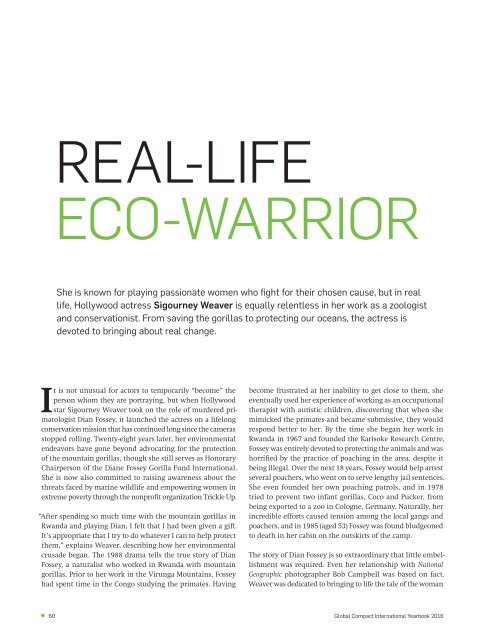Global Compact International Yearbook 2016
The Sustainable Development Goals are an ambitious agenda with 17 topics addressing the global challenges of our time. A key topic is innovation: Business must fit into planetary boundaries. This probably will not work with traditional business models. That is why we need new, fresh ideas. We need change, even when it happens in a rough, disruptive way. And the earlier the better. This is why the upcoming edition of the Global Compact International Yearbook, published in September 2016, has chosen sustainable innovation as the key topic. Also includes exclusive interviews with Angelina Jolie, Robert Redford and Sigourney Weaver. The Global Compact International Yearbook is with more than 500,000 readers one of the worlds leading CSR publications. Münster/New York 2016: 164 pages, paperback Publishing houses: macondo publishing/UN Publications Subscription (via UN Publications only): 30.00 USD (regular) 15.00 USD (reduced) ISBN13: 978-3-946284-01-7 / ISSN-Print: 2365-3396 / ISSN-Internet: 2365-340x
The Sustainable Development Goals are an ambitious agenda with 17 topics addressing the global challenges of our time. A key topic is innovation: Business must fit into planetary boundaries. This probably will not work with traditional business models. That is why we need new, fresh ideas. We need change, even when it happens in a rough, disruptive way. And the earlier the better. This is why the upcoming edition of the Global Compact International Yearbook, published in September 2016, has chosen sustainable innovation as the key topic.
Also includes exclusive interviews with Angelina Jolie, Robert Redford and Sigourney Weaver.
The Global Compact International Yearbook is with more than 500,000 readers one of the worlds leading CSR publications.
Münster/New York 2016: 164 pages, paperback
Publishing houses: macondo publishing/UN Publications
Subscription (via UN Publications only): 30.00 USD (regular) 15.00 USD (reduced)
ISBN13: 978-3-946284-01-7 / ISSN-Print: 2365-3396 / ISSN-Internet: 2365-340x
You also want an ePaper? Increase the reach of your titles
YUMPU automatically turns print PDFs into web optimized ePapers that Google loves.
Real-life<br />
Eco-warrior<br />
She is known for playing passionate women who fight for their chosen cause, but in real<br />
life, Hollywood actress Sigourney Weaver is equally relentless in her work as a zoologist<br />
and conservationist. From saving the gorillas to protecting our oceans, the actress is<br />
devoted to bringing about real change.<br />
It is not unusual for actors to temporarily “become” the<br />
person whom they are portraying, but when Hollywood<br />
star Sigourney Weaver took on the role of murdered primatologist<br />
Dian Fossey, it launched the actress on a lifelong<br />
conservation mission that has continued long since the cameras<br />
stopped rolling. Twenty-eight years later, her environmental<br />
endeavors have gone beyond advocating for the protection<br />
of the mountain gorillas, though she still serves as Honorary<br />
Chairperson of the Diane Fossey Gorilla Fund <strong>International</strong>.<br />
She is now also committed to raising awareness about the<br />
threats faced by marine wildlife and empowering women in<br />
extreme poverty through the nonprofit organization Trickle Up.<br />
“After spending so much time with the mountain gorillas in<br />
Rwanda and playing Dian, I felt that I had been given a gift.<br />
It’s appropriate that I try to do whatever I can to help protect<br />
them,” explains Weaver, describing how her environmental<br />
crusade began. The 1988 drama tells the true story of Dian<br />
Fossey, a naturalist who worked in Rwanda with mountain<br />
gorillas. Prior to her work in the Virunga Mountains, Fossey<br />
had spent time in the Congo studying the primates. Having<br />
become frustrated at her inability to get close to them, she<br />
eventually used her experience of working as an occupational<br />
therapist with autistic children, discovering that when she<br />
mimicked the primates and became submissive, they would<br />
respond better to her. By the time she began her work in<br />
Rwanda in 1967 and founded the Karisoke Research Centre,<br />
Fossey was entirely devoted to protecting the animals and was<br />
horrified by the practice of poaching in the area, despite it<br />
being illegal. Over the next 18 years, Fossey would help arrest<br />
several poachers, who went on to serve lengthy jail sentences.<br />
She even founded her own poaching patrols, and in 1978<br />
tried to prevent two infant gorillas, Coco and Pucker, from<br />
being exported to a zoo in Cologne, Germany. Naturally, her<br />
incredible efforts caused tension among the local gangs and<br />
poachers, and in 1985 (aged 53) Fossey was found bludgeoned<br />
to death in her cabin on the outskirts of the camp.<br />
The story of Dian Fossey is so extraordinary that little embellishment<br />
was required. Even her relationship with National<br />
Geographic photographer Bob Campbell was based on fact.<br />
Weaver was dedicated to bringing to life the tale of the woman<br />
60<br />
<strong>Global</strong> <strong>Compact</strong> <strong>International</strong> <strong>Yearbook</strong> <strong>2016</strong>

















